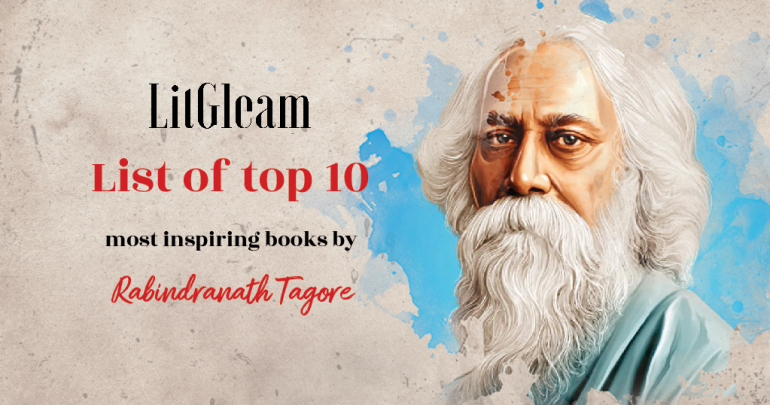Here’s a list of top books by Rabindranath Tagore. Revered as Gurudev and Biswakabi, the Bengali poet, writer, singer, and painter Rabindranath Tagore is amongst the most famous Indian authors and illuminated Bengali Literature with his glorious poetry, short stories, and novels. A man of many talents, Tagore was the one to confer Gandhi with the renowned title of Mahatma and was known to be a good friend of Albert Einstein as they shared similar interests in music.
He was globally acclaimed for his collection of poems Gitanjali and was the first non-European Nobel Laureate as he was honoured with a Nobel Prize in Literature in 1913. If you are planning to explore the amazing works of this well-known Bard of Bengal, we have curated a perfect reading list of famous books by Rabindranath Tagore in this article.
- Gitanjali – It is actually an anthology of poetry and is the most renowned and influential work by Rabindranath Tagore. Published originally in 1910, Tagore rereleased it as a series of translated prose poems in English, titled ‘Gitanjali: Song Offerings’, and came out in printed form in the year 1912. W.B. Yeats authored the introduction of the English version. Tagore was inspired by the Indian lyrics of devotion from medieval times and emphasized on ‘Love’ is the principal subject of Gitanjali. Amongst the most famous books by Rabindranath Tagore, this series was internationally lauded for its musical and rhythmic poetry and led Tagore to win the Nobel Prize in Literature in 1913.
- The Home and The World – Originally named Ghare Baire in Bengali, The Home, and the World is a novel set in the early years of the Indian independence struggle and was published in the year 1916. In the context of the Swadeshi Movement, Tagore has masterfully created three characters, Nikhil, Bimala, and Sandip, struggling with their own ideas about the self-amidst the revolutionary times of the freedom struggle in India. As both a love story and political saga, the novel beautifully portrays Tagore’s self-struggle as he was torn between the cultural ideas of the West and his defiance against them. Amongst the famous books by Rabindranath Tagore which has strikingly broken the traditional portrayal of male and female protagonists, it has also underlined several aspects of the Swadeshi movement through the contrast between conventional and radical perspectives.
- The Postmaster – Known to be written by him in complete isolation, The Postmaster established Tagore as India’s greatest romantic as the story beautifully explores the human condition and its varied forms, from the innocence of childhood to the contrast between a bustling city and the rustic village as well as love and loss and the natural and supernatural! It is one of the best books by Rabindranath Tagore which you can pick if you are just starting out with reading his immensely rich and amazingly endearing literature. Often referred to as the first modern Indian novel, Chokher Bali tells the story of a beautiful and educated widow Binodini in a society that believed in isolating widows from the community and leaving them for a life filled with despair and nothingness. As a well-read woman, Binodini is aware of this negligence prevalent towards widows in her society and as the novel progresses, Tagore intricately builds a complicated web of relationships which begins with Binodini’s jealousy towards Mahim and Asha’s marital bliss and concludes with her leaving a potentially happy ending which is something largely debated on. Amongst the famous books by Rabindranath Tagore, this novel brings an incredible interplay of relationships and has been adapted to the silver screen in 2003 by Rituparno Ghosh and starred Aishwarya Rai as Binodini.
- Fireflies – Another uniquely written series of Proverbs, Aphorisms, and Maxims, Fireflies is among the popular poetry books by Rabindranath Tagore. The title of this work is inspired by the initial lines of his poem ‘Lekhan’ which reads as ‘My fancies are fireflies. It is a collection of 256 poems, and verses and has many parallels with his popular epigram ‘Stray Birds.’ Poetry in this book is presented more like aphorisms and maxims than actual poems. Many critics do not rule out the potential influence of Japanese Haiku’. The brevity of these poems has not stopped Tagore from expressing different poetic ideas with sheer eloquence. While going through these poems a reader is swept with delight and awe.
- The Post Office – The Post Office or Dak Ghar is actually a play written by Rabindranath Tagore and tells the story of a child’s liberation not only in terms of physical context but also social, psychological, and emotional freedom. The protagonist of the play is Amal, who is a small boy who languished between the four walls of his uncle’s home due to an irrecoverable illness. W.B. Yeats produced its maiden English version. In 1913 it was played first in an Irish theatre located in London. Tagore was also a part of the audience. In Bengal, it was played in 1917 in the city of Calcutta. In Germany, its run lasted for over 105 dazzling performances all over the country. It is also one of the most adapted plays by Rabindranath Tagore and can be a perfect quarantine read for your pastime as we are all confined within the four walls of our homes.
- Gora – Amongst the long list of excellently written works by Rabindranath Tagore, Gora finely portrays the social, political, and religious society of Bengal during the colonial rule of the 1880s. It is Tagore’s fifth literary novel and brings forwards the profoundly created protagonist Gora who is fraught with philosophical questions, theological and political debate, as well as on the subjects of freedom, universal brotherhood, gender, female rights, the malaise of caste, class disparity, tradition and modernity, urban and rural gap, nationalism, colonialism, and much more.
- Waiting – In this poem, Tagore talks about recognizing the divine within oneself. Tagore was a man who was deeply inspired by Hindu philosophy, especially the Upanishads. He refers to the Hindu belief that God resides as the soul in each being. Therefore, devotion or spirituality, according to him, is a deeply personal journey. He tries to make the reader understand that devotion is progression till we reckon with our innermost self. Tagore says that although he as a seeker is progressing towards unison with god, he says it cannot happen as his own journey toward enlightenment is still developing.
- Friend – This poem is more of a dialogue in nature. Tagore, in this poem, expresses his concern to a friend who is braving a storm in order to visit him. The speaker of this poem says that because the friend is coming to visit him, despite the bad weather, he wouldn’t rest until his friend reaches. Due to the heavy storm, the poet laments being unable to spot anything outside and consequently worries about his well-being. Enunciating the shore of the black river and the depth of gloom outside he wonders if his friend is shortening his life, only to visit him.
- On The Nature of Love – This poem by Tagore elucidates the quest that an individual undergoes in order to find their partner. The subject of this poem is the physical search for a life partner or a companion. The poem rests on the idea that our life partner is predestined and therefore the poet is seen to be searching for his soul mate. In this poem, the search through the forest is the search for true love and the lightning represents destiny, which according to the poem is the end of the final search. To put it simply, life according to the poet is a quest for a soulmate that seems to be never-ending. The driving force for pursuing the search is that it would bring eternal happiness upon its completion.
- Paper boats – Paperboat is a poem from his collection ‘The crescent Moon’ which captures the childhood memory of the poet. Much like Wordsworth and Walter de la Mare, Tagore finds a mystic quality in his children. This poem puts forth a child’s experience of floating paper boats down a stream and evinces the innocent psychology of a child. In this poem, Tagore shows a keen insight into the innocence and purity of a child’s mind. I cherished his heartfelt stories and eloquent characters who were way ahead of their times.
Rabindranath Tagore’s literary world was reflected in the many colours of Bengali society and culture and his aspirations of an ideal world filled with strong and determined yet humane characters.
We hope that our list of famous books by Rabindranath Tagore helps you explore the colossally exquisite literature of Gurudev.




